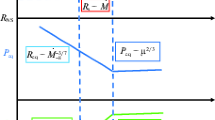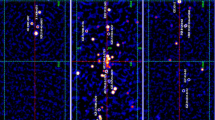Abstract
A model of the population of ultraluminous X-ray sources (ULXs) in binary systems with black hole (BH) accretors is constructed by hybrid population synthesis and is compared with the model of the population of ULXs with magnetized neutron stars (NSs) that can be observed as pulsating ULXs (Kuranov et al. 2020). A model of the formation of BHs whereby their mass is determined by the mass of the CO core immediately before its collapse (\(M_{\mathrm{CO}}\)) and ‘‘delayed’’ and ‘‘rapid’’ collapse models (Fryer et al. 2012) are considered. The possible transiency of ULXs due to accretion disk instability is taken into account. The parameters and evolution of ULXs in galaxies with a constant star formation rate (SFR) and in those with an old stellar population after an instantaneous star formation burst are computed. The maximum number of ULXs with BHs (\({\sim}10\)) is reached in galaxies with a stationary \(SFR=10M_{\odot}\) yr\({}^{-1}\) \({\sim}1\) Gyr after the beginning of star formation. ULXs observed after the end of star formation are close binary systems in which BHs and/or NSs formed before the end of star formation, while long-lived donors with a mass \({\sim}M_{\odot}\) continue to overflow their Roche lobes after its end or have filled their Roche lobes even later. Several Gyr after the end of star formation the number of ULXs in galaxies with a mass \(M_{G}=10^{10}M_{\odot}\) is no more than 0.1, most of them are ULXs with NSs. Persistent sources with a Roche-lobe-overflowing optical star dominate in ULXs with NSs, irrespective of the adopted star formation model. The transient sources are an order of magnitude fewer. The ULXs accreting from the stellar wind of the optical component are an order of magnitude fewer than the sources with accretion via Roche lobe overflow.















Similar content being viewed by others
Notes
The changes introduced by us into the code make it, as our tests show, almost identical to the new author’s version of BSE (Banerjee et al. 2020).
Eq. (12) from Paper I.
Laplace et al. (2021) studied this issue in detail, but only for the ranges of masses corresponding to the NS progenitors. They also drew attention to the fact that the isotopic composition of presupernovae in these cases is different.
REFERENCES
M. A. Abramowicz, B. Czerny, J.-P. Lasota, et al., Astrophys. J. 332, 646 (1988).
E. Ambrosi, L. Zampieri, F. Pintore, and A. Wolter, arXiv: 2111.02879 (2021).
P. Atri, J. C. A. Miller-Jones, A. Bahramian, et al., Mon. Not. R. Astron. Soc. 489, 3116 (2019).
M. Bachetti et al., Nature (London, U.K.) 514, 202 (2014).
S. Banerjee, K. Belczynski, C.-L. Fryer, et al., Astron. Astrophys. 639, A41 (2020).
E. R. Beasor, B. Davies, and N. Smith, arXiv: 2109.03239 (2021).
M. C. Bernadich, A. D. Schwope, K. Kovlakas, et al., arXiv: 2110.14562 (2021).
B. Binder, E. M. Levesque, and T. Dorn-Wallenstein, Astrophys. J. 863, 41 (2018).
T. A. Callister, W. M. Farr, and M. Renzo, Astrophys. J. 920, 157 (2021).
A. M. Cherepashchuk, Phys. Usp. 59, 702 (2016).
E. J. M. Colbert and R. F. Mushotzky, Astrophys. J. 519, 89 (1999).
M. Coriat, R. P. Fender, and G. Dubus, Mon. Not. R. Astron. Soc. 424, 1991 (2012).
L. Dessart, A. Burrows, C.-D. Ott, et al., Astrophys. J. 644, 1063 (2006).
G. Dubus, J.-P. Lasota, J.-M. Hameury, et al., Mon. Not. R. Astron. Soc. 303, 139 (1999).
I. El Mellah, J. O. Sundqvist, and R. Keppens, Astron. Astrophys. 622, L3 (2019).
T. Ertl, S. E. Woosley, T. Sukhbold, et al., Astrophys. J. 890, 51 (2020).
S. N. Fabrika and A. V. Mescheryakov, in Proceedings of the IAU Symposium No. 205, Ed. by R. T. Schilizzi (2001), p. 268.
S. N. Fabrika, K. E. Atapin, A. S. Vinokurov, et al., Astrophys. Bull. 76, 6 (2021).
E. Fonseca, H. T. Cromartie, T. T. Pennucci, et al., Astrophys. J. Lett. 915, L12 (2021).
C. L. Fryer, K. Belczynski, G. Wiktorowicz, et al., Astrophys. J. 749, 91 (2012).
M. Gallegos-Garcia, C. P. L. Berry, P. Marchant, et al., arXiv: 2107.05702 (2021).
N. Giacobbo and M. Mapelli, Mon. Not. R. Astron. Soc. 480, 2011 (2018).
S. A. Grebenev, Astron. Lett. 43, 464 (2017).
J.-M. Hameury and J.-P. Lasota, Astron. Astrophys. 643, A171 (2020).
R. Hirai and I. Mandel, arXiv: 2108.03774 (2021).
G. Hobbs et al., Mon. Not. R. Astron. Soc. 360, 974 (2005).
J. Hurley et al., Mon. Not. R. Astron. Soc. 329, 897 (2002).
G. L. Israel et al., Mon. Not. R. Astron. Soc. 466, L48 (2017).
N. Ivanova, S. Justham, X. Chen, et al., Astron. Astrophys. Rev. 21, 59 (2013).
N. Ivanova, S. Justham, and P. Ricker, Common Envelope Evolution, AAS-IOP Astron. Book Ser. (IOP, Boston, 2020).
C. de Jager, H. Nieuwenhuijzen, and K. A. van der Hucht, Astron. Astrophys. Suppl. Ser. 72, 259 (1988).
P. Kaaret, H. Feng, T. Roberts, et al., Ann. Rev. Astron. Astrophys. 55, 303 (2017).
A. King et al., Astrophys. J. Lett. 552, L109 (2001).
A. R. King, Mon. Not. R. Astron. Soc. 393, L41 (2009).
R. Kippenhahn and A. Weigert, Zeitschr. Astrophys. 65, 251 (1967).
R. Kippenhahn, K. Kohl, and A. Weigert, Zeitschr. Astrophys. 66, 58 (1967).
J. Klencki, G. Nelemans, A. G. Istrate, et al., Astron. Astrophys. 638, A55 (2020).
J. Klencki, G. Nelemans, A. G. Istrate, et al., Astron. Astrophys. 645, A54 (2021a).
J. Klencki, A. G. Istrate, G. Nelemans, et al., arXiv: 2111.10271 (2021b).
M. de Kool, Astrophys. J. 358, 189 (1990).
A. G. Kuranov, K. A. Postnov, and L. R. Yungel’son, Astron. Lett. 46, 658 (2020).
E. Laplace, S. Justham, M. Renzo, et al., arXiv: 2102.05036 (2021).
K. M. López, M. Heida, P. G. Jonker, et al., Mon. Not. R. Astron. Soc. 497, 917 (2020).
E. Lovegrove and S. E. Woosley, Astrophys. J. 769, 109 (2013).
A.-J. Loveridge et al., Astrophys. J. 743, 49 (2011).
M. MacLeod, E. C. Ostriker, and R. Stone, Astrophys. J. 863, 5 (2018).
P. Marchant et al., Astron. Astrophys. 604, A55 (2017).
A. Miglio, C. Chiappini, J. T. Mackereth, et al., Astron. Astrophys. 645, A85 (2021).
S. Motch et al., Nature (London, U.K.) 514, 198 (2014).
A. A. Mushtukov et al., Mon. Not. R. Astron. Soc. 501, 2424 (2021).
D. K. Nadezhin, Astroph. Space Sci. 69, 115 (1980).
T. Nugis and H. J. G. L. M. Lamers, Astron. Astrophys. 360, 227 (2000).
B. Paxton et al., Astrophys. J. Suppl. Ser. 192, 3 (2011).
M. Plavec, R. K. Ulrich, and R. S. Polidan, Publ. Astron. Soc. Pacif. 85, 769 (1973).
A. J. T. Poelarends, S. Wurtz, J. Tarka, et al., Astrophys. J. 850, 197 (2017).
C. A. Raithel, T. Sukhbold, and F. Özel, Astrophys. J. 856, 35 (2018).
N. I. Shakura and R. A. Sunyaev, Astron. Astrophys. 24, 337 (1973).
Y. Shao and X.-D. Li, Astrophys. J. 802, 131 (2015).
Y. Shao et al., Astrophys. J. 886, 118 (2019).
S. J. Smartt, Publ. Astron. Soc. Austral. 32, 016 (2015).
G. E. Soberman et al., Astron. Astrophys. 327, 620 (1997).
S. S. Tsygankov, A. A. Mushtukov, V. F. Suleimanov, et al., Mon. Not. R. Astron. Soc. 457, 1101 (2016).
A. V. Tutukov, L. R. Yungel’son, and A. Klyaiman, Nauch. Inform. 27, 3 (1973).
J. S. Vink, arXiv: 2109.08164 (2021).
J. S. Vink, A. de Koter, and H. J. G. L. M. Lamers, Astron. Astrophys. 362, 295 (2000).
J. Vink et al., Astron. Astrophys. 369, 574 (2001).
M. Volonteri, M. Habouzit, and M. Colpi, Nat. Rev. Phys. 3, 732 (2021).
D. J. Walton et al., Astrophys. J. Lett. 857, L3 (2018).
D. J. Walton, A. D. A. Mackenzie, H. Gully, et al., Mon. Not. R. Astron. Soc. (2021); arXiv: 2110.07625.
R. F. Webbink, Astrophys. J. 277, 355 (1984).
N. E. White and J. van Paradijs, Astrophys. J. Lett. 473, L25 (1996).
G. Wiktorowicz et al., Astrophys. J. 846, 17 (2017).
G. Wiktorowicz et al., Astrophys. J. 875, 53 (2019).
G. Wiktorowicz, J.-P. Lasota, K. Belczynski, et al., Astrophys. J. 918, 60 (2021).
F. Yuan and R. Narayan, Annual Rev. Astron. Astrophys. 52, 529 (2014).
Funding
This study was supported by the Russian Foundation for Basic Research (project no. 19-02-00790). A.G. Kuranov and K.A. Postnov were supported by the Interdisciplinary Scientific and Educational School of the Moscow Sate University ‘‘Fundamental and Applied Space Research’’. L.R. Yungelson was supported in part by the Russian Foundation for Basic Research (project no. 19-07-01198).
Author information
Authors and Affiliations
Corresponding author
Additional information
Translated by V. Astakhov
Rights and permissions
About this article
Cite this article
Kuranov, A.G., Postnov, K.A. & Yungelson, L.R. Populations of Ultraluminous X-ray Sources in Galaxies: Origin and Evolution. Astron. Lett. 47, 831–855 (2021). https://doi.org/10.1134/S1063773721120021
Received:
Revised:
Accepted:
Published:
Issue Date:
DOI: https://doi.org/10.1134/S1063773721120021




